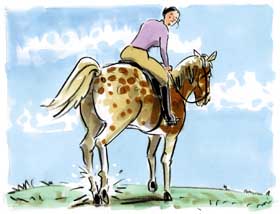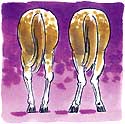|
hind hoof will curve inward and aim toward the other hind leg. If your horse is
cow-hocked, the same inward winging may occur, but because the hind limbs are
further apart, you will not notice any bumps or cuts. If you are still unsure
about how your horse is affected, stand behind it to measure the inward pattern
on the affected leg.
 Generally
speaking, when such an animal’s hind hoof touches the ground, the hock itself
will be caused to move at and outward arch which in turn proves that there is a
lack of stability, which may cause the interference. Affected base narrow horses
– as well as those classified as cow-hocked – will evidence rear hooves that
roll off as they bear weight, which then permits the inside of the hoof to amble
toward the inside of the other hind leg. Generally
speaking, when such an animal’s hind hoof touches the ground, the hock itself
will be caused to move at and outward arch which in turn proves that there is a
lack of stability, which may cause the interference. Affected base narrow horses
– as well as those classified as cow-hocked – will evidence rear hooves that
roll off as they bear weight, which then permits the inside of the hoof to amble
toward the inside of the other hind leg.
If your horse only suffers from a temporary gait problem, you will be able to
resolve the issue with some time and patience. Proper training and strengthening
of the hind muscles will gradually help the animal to limit its interference.
Conversely, if the shoes of the horse are too small, this may be corrected by
re-shoeing the horse with properly fitting shoes. To protect the fetlocks
against further injury until they are healed, you may consider covering them
with protective boots. Conformity issues may be addressed by your farrier who
should take the time to observe the animal at a trot to note the stepping
patterns.
 In
addition, using some carpenter’s chalk and applying it to the inside of the hoof
will help you to find out if and where interference may be occurring.
Additionally, you will be able to tell the degree of interference. When a horse
is known to be base narrow, you will want to trim the hooves in such a way that
the inside wall of the hoof is lowered. If the animal is cow-hocked, on the
other hand, the outside of the hoof wall needs to be lowered. In
addition, using some carpenter’s chalk and applying it to the inside of the hoof
will help you to find out if and where interference may be occurring.
Additionally, you will be able to tell the degree of interference. When a horse
is known to be base narrow, you will want to trim the hooves in such a way that
the inside wall of the hoof is lowered. If the animal is cow-hocked, on the
other hand, the outside of the hoof wall needs to be lowered.
Discuss the problems with your farrier who will be able to make suggestions and
also help you to understand exactly what you need to look for. Of course, there
are also other gain abnormalities that may affect your horse. One such
abnormality is referred to as “forging” and it happens when the hind hoof’s toe
makes contact with the heel of the front hoof on the same side. If your horse is
wearing shoes, you will hear a consistent annoying clicking sound. The reason
for this abnormality is often found in a front limb that is too slow to get out
of the way of the hind limb. Another version of this abnormality is referred to
as “overreaching” and you will see it in a trotting horse where the toe section
of the rear hoof makes square contact with the heel bulb of the front hoof.
Shoes will be pulled and lacerations to the heel bulb are frequent occurrences.
Forging may be noticed in animals that are tired, old, improperly conformed, or
ridden by inexpert individuals. Look at young horses who have just experienced a
growth spurt and you will see a great example of a temporary form of improper
conformation. Another cause of forging could be the lameness of a forelimb. For
example, if the animal experiences pain in it forelimb, it will adjust its gait
and thus the missing extension will oftentimes result in the development of
forging. A local anesthetic used to block the front feet will usually help the
animal resolve its gait problem, but will then require another examination for
the cause of the lameness.
 Allow
your farrier to assist you by improving the timing of the gait, such as she or
he would be able to facilitate the speeding up for the breakover of the front
hooves and slowing down the advance of the rear hooves. Trimming of excessive
front toe lengths will help, as will the use of a rocker-toe shoe. Trimming of
the hind hooves so as to move the heel toward the most open portion of the grog
will help create a sturdy ground surface. A square toe shoe decreases the
overall breakover. It may take a little time to correct this gait abnormality,
yet if you find that in spite of all efforts the problem remains, then perhaps
the animal is unsuited for the kinds of athletic exercises you are putting it
through. Allow
your farrier to assist you by improving the timing of the gait, such as she or
he would be able to facilitate the speeding up for the breakover of the front
hooves and slowing down the advance of the rear hooves. Trimming of excessive
front toe lengths will help, as will the use of a rocker-toe shoe. Trimming of
the hind hooves so as to move the heel toward the most open portion of the grog
will help create a sturdy ground surface. A square toe shoe decreases the
overall breakover. It may take a little time to correct this gait abnormality,
yet if you find that in spite of all efforts the problem remains, then perhaps
the animal is unsuited for the kinds of athletic exercises you are putting it
through.

|